PAGE 2 of 2 - Scanning the output of an RC5 compatible Philips remote control
Luckily, i happen to have an old Philips remote control which supports both the RC6 and RC5 protocols. The primary protocol it uses is RC6, but it can be switched to RC5 by pressing a button on its side.
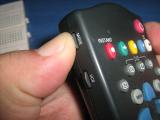 |
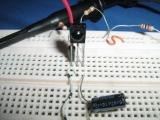 |
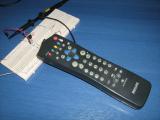 |
| My old and busted remote control supports both RC6 and RC5 protocols |
I used an IR receiver to monitor the IR output of the transmitter |
|
This is a snapshot of the first signal that i captured. There are actually two packets of IR data sent by the control captured in the screen. The interval between these packets is 89 mSec. Actually, it should be 100 mSec (as the Philips specifications), but obviously a shorter interval still works:
Then i decreased the mSec/div of the oscilloscope to "zoom in" the signal. Here is a real-life RC5 signal sent by a Philips remote control:
The packet duration appears to be 23.2 mSec but it is not 100% correct, because there is another half period at the end of the transmitted signal which is not measured, so if we add up another half signal (1.7/2=0.85) we come up with the correct packet length (almost). Keep in mind that the precise durations as per Philips specifications are usually not 100% followed due to technical difficulties.
Now, here is something interesting. Can you decode the previous screenshot of the signal? If this is the first time that you try to do it it might be hard... Here is a little help:
| | 
Click to enlarge | |
If you haven't found it, the bits are "11000101000000", which means 1 for start-bit, 1 for field-bit, 0 for toggle-bit, the address is 101 (00101) which means VCR and the data is 0 (000000). Actually, this screenshot is taken when i pressed the button "0" on the remote control.
Here are two screenshots to see the toggle bit changing. I press the same button twice (button 0):
Finally, here is a set of screenshots with different buttons pressed. I tried to maintain the same toggle bit for all screenshots, because i wanted to indicate only the change in the last 6 data bits. To do so, i had to press each button twice to invert and re-invert the toggle bit...
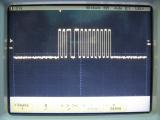 |
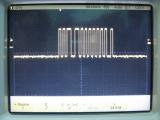 |
 |
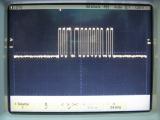 |
| Button 0 |
Button 1 |
Button 2 |
Button 3 |
 |
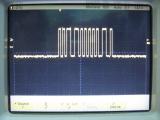 |
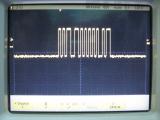 |
| Button 4 |
Button 5 |
Button 6 |
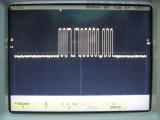 |
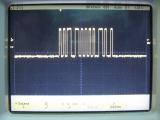 |
 |
| Button 7 |
Button 8 |
Button 9 |
As for the carrier frequency...
To capture the carrier frequency i had to change the receiver setup. Instead of an integrated IR receiver (TSOP chip) i used a simple IR diode. The diode has no filters, so the signal which appears on the oscilloscope is the pure signal being transmitted by the IR LED of the remote control:
 |
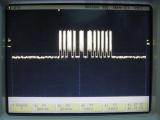 |
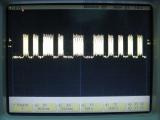 |
 |
| I used a simple IR diode to capture the carrier frequency |
This is the packet sent as captured by the IR diode |
A little "zoom-in" makes the carrier frequency visible |
More zoom-in and the carrier frequency is measurable. 36KHz |
Comments
At 29 July 2015, 11:32:11 user Kumar Satyam wrote: [reply @ Kumar Satyam]Bit period (transmission clock): 1,778 mSec
should be corrected to:
Bit period (transmission clock): 1.778 mSec
At 22 March 2014, 16:17:02 user Giorgos Lazaridis wrote: [reply @ Giorgos Lazaridis]@poonam 38KHz is the frequency (F). The period (T) is:
T = 1/F => T = 1/38000 = 26,3 uSec
At 22 March 2014, 12:35:27 user poonam wrote: [reply @ poonam]nice xplination...sir but i have tsop1738 which is operated for 38KHZ frequency..can i knw the time period between each bit.We required that for our project automatic curtains..thanxx
At 15 August 2013, 9:11:07 user raushan wrote: [reply @ raushan]you are giving basic idea of the RC5 protocol in very simple and understable way , thanks for it .but sir now tell me how i interface with avr16 or any micro-controller
At 16 July 2013, 4:51:25 user Rohan wrote: [reply @ Rohan]good information is provided... thnx..
At 14 February 2013, 13:07:13 user Giorgos Lazaridis wrote: [reply @ Giorgos Lazaridis]@mary http://www.pcbheaven.com/userpages/philips_rc5_decoder_transmitter
At 11 February 2013, 3:04:21 user mary wrote: [reply @ mary]@Giorgos Lazaridis @Giorgos Lazaridis
for the IR led have you connected 5v power supply as well as the ve teminal of dso TO the anode of IR led if im wrong plz tell me the connections
At 25 January 2013, 20:17:24 user Giorgos Lazaridis wrote: [reply @ Giorgos Lazaridis]@mary there is an application note on this chip datasheet
At 25 January 2013, 15:24:36 user mary wrote: [reply @ mary]i want to see the rc code on DSO but how do i connect the tsop with resistors & capcitors & plz tell me their values.2)im dong a prjt on remote ctrl of home aplliances using PHillips remote if i want to change the speed of fan which is one of the appliances what must i do.plzzzzzzz help
At 27 December 2012, 7:15:36 user JIRSHAD wrote: [reply @ JIRSHAD]Thank you for giving me a breakthrough in my project...!!!!!
At 26 October 2012, 15:14:46 user Alfredo Matignon wrote: [reply @ Alfredo Matignon]Excellent article and references. Thanks
At 4 September 2012, 20:48:27 user Sam Coleman wrote: [reply @ Sam Coleman]Very useful page. The bit period should read 1,778 uSec though. |
|
 HOT in heaven! HOT in heaven!

|
|

 Home
Home
 Projects
Projects
 Experiments
Experiments
 Circuits
Circuits
 Theory
Theory
 BLOG
BLOG
 PIC Tutorials
PIC Tutorials
 Time for Science
Time for Science
 Contact
Contact
 Forum
Forum
 Projects
Projects
 Experiments
Experiments
 Circuits
Circuits
 Theory
Theory
 BLOG
BLOG
 PIC Tutorials
PIC Tutorials
 Time for Science
Time for Science
 RSS
RSS